Latest News
Kitchen Chat and more…
Kitchen Chat and more…
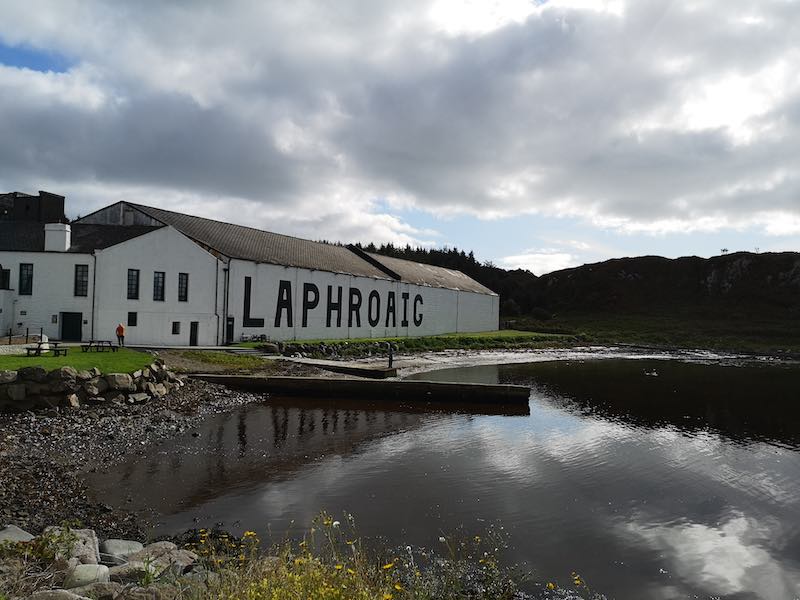
Laphroaig Distillery
Laphroaig distillery is home to the world-famous whisky of the same name. It is a whisky that causes heated debates over how it tasted, and can seriously make one person look demented in the eyes of another. However controversial the whisky may appear to taste, Laphroaig distillery is a place that excites whisky drinkers all over the world.
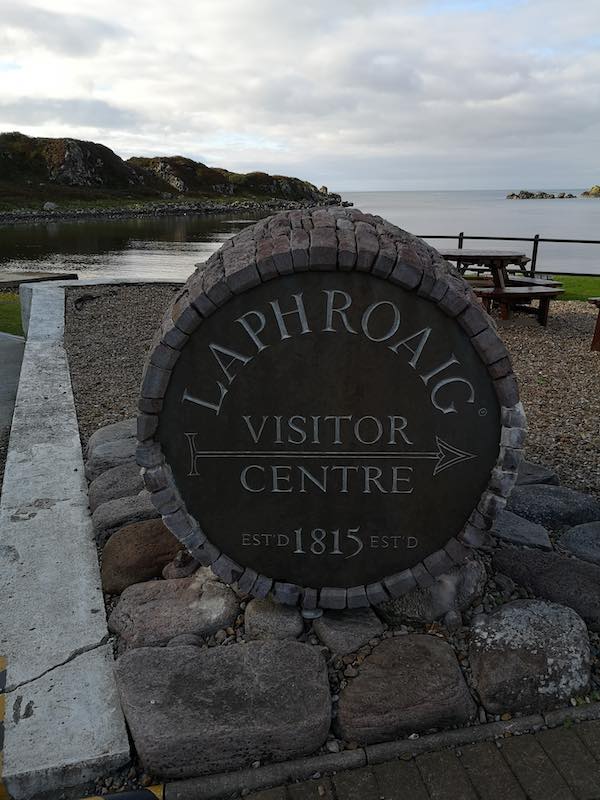
Entrance to Laphroaig Visitor Centre
We visited Laphroaig Distillery on a sunny morning for a tour and tasting. Having a driver who used to work at Laphroaig Distillery as a Stillman made it extra special for us as our dear driver introduced us to everyone at the visitor centre! We arrived earlier than expected, and excitedly, try to explore the little museum located at the visitor centre. It is a small area detailing the history of Laphroaig, as well as providing some explanation to what peat is.
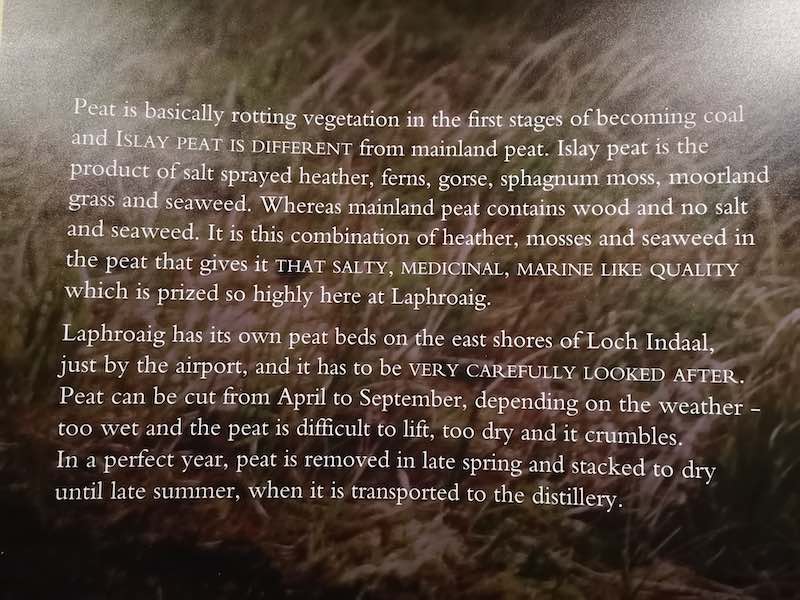
Peat Explained
After going through the museum, we met our tour guide for the day and started our tour.
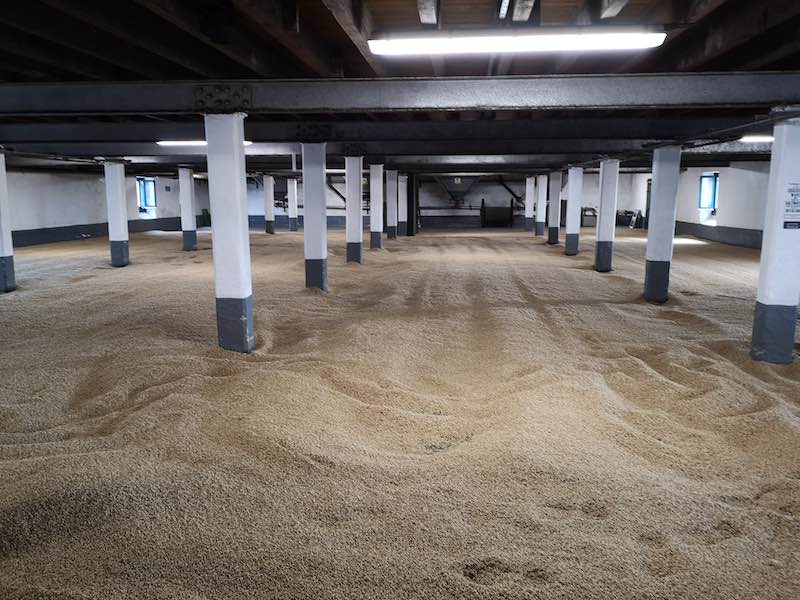
Malting Floor
Laphroaig malts some of their barley at the distillery and buys the rest of them from Port Ellen Malting. The first step of malting barley is naturally seeping them in water. Barley seeped in water for roughly 48 hours. The time depends on the temperature and how fast the barley reacts as the barley needs to get a moisture content of 45% before they are used in the next step.
The team at the malting hall changes the water regularly to keep the water fresh. Draining the water also helps to allow the barley to breathe before refilling it to continue the seeping process. Once the barley is ready, they will be spread onto the floor. The ideal temperature during the germination is about 18 degrees C to make sure that the barley is ready for the kiln. However, due to weather changes, the distillery needs to monitor the temperature carefully and make changes when necessary. In cold weather, the team keeps the barley warm by closing the windows; in hot weather, the windows are opened to keep the barley cool and well-ventilated.
During germination, the team works hard to keep the barley fresh by turning them regularly. The process helps to ventilate the barley and prevent them from sticking to one another. It also allows the barley to breathe and germinate properly. During the tour, the guide allowed everyone to help turn the barley using a shovel that they kept to the malting floor. We were very excited to try that as it would be the first time that we get to do it!
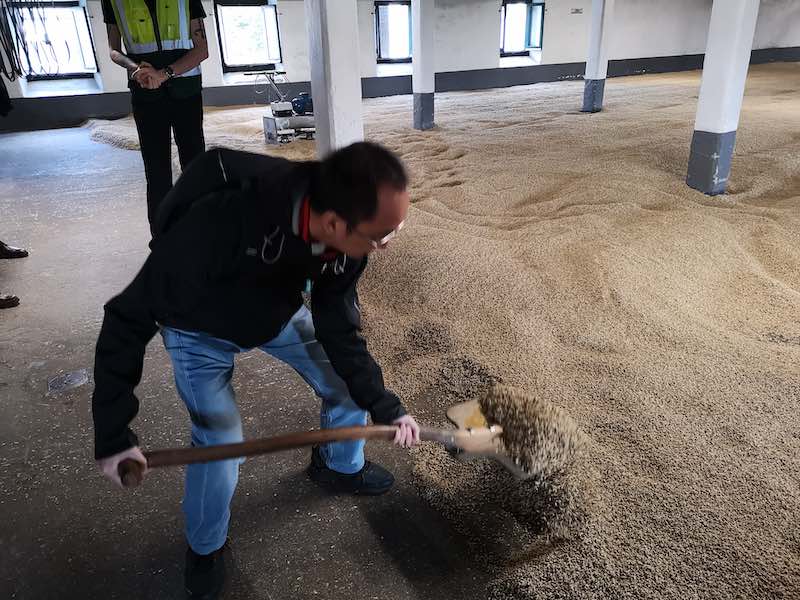
Turning the Barley!
Here we were! Holding the shovel for the first time, and scooping barley in the attempt to turn it! It was great fun, honestly, with every one of us making a pose for pictures and videos! The barley germinates better with the regular turning, and soon, it would be ready for milling before moving on to the next step.
The germinated barley needs to be dried to stop the growth and make it useful for whisky-making. Maltsers transferred the barley to the kiln when it is ready. The kiln is responsible for both the smoking and drying of the barley. They do the two processes separately. Smoking using peat takes about 12 hours while the drying time depends on the moisture content. The team needs to dry the barley down to 2% moisture.
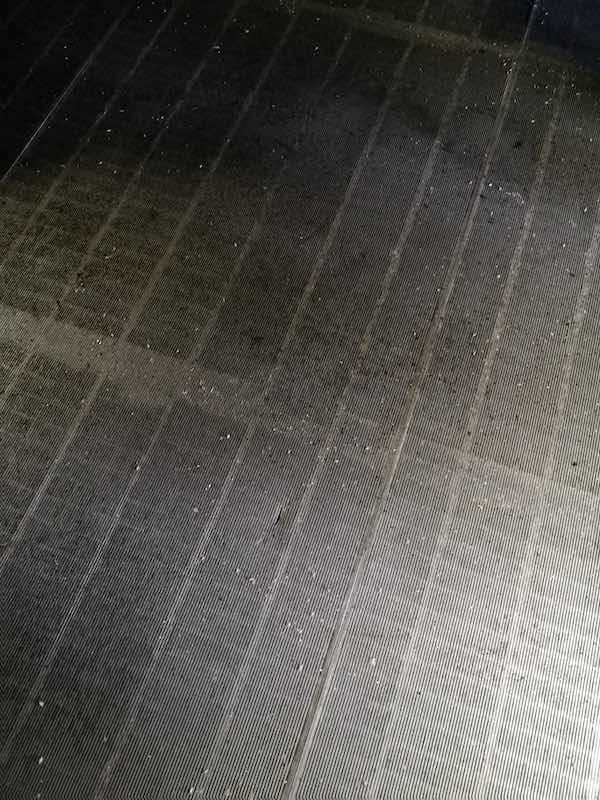
The place the barley rest on
To smoke and dry the barley, the team sends the barley to this “resting floor” above the kiln. The guide took us in to take a look and also to have a feel of getting smoked! The germinated barley gets spread out on the floor before they lit the fire below for the smoking and drying process.

The Kiln
This is the kiln at Laphroaig. As it was one of the slower periods in whisky-making, we got a chance to see the kiln when it was not in use. The team will pile peat into the kiln, light it up, and the smoke that rises will reach the floor above where the barley lies. As mentioned earlier, the smoking process takes 12 hours. After that, drying takes place. As mentioned earlier, the distillery takes part of its malted barley from Port Ellen Malting. We understood from our guide that the malt from Port Ellen is around 40-45ppm while the malts from Laphroaig is around 50-55ppm. To achieve an average, the distillery mixes the two malts to get a good balance.
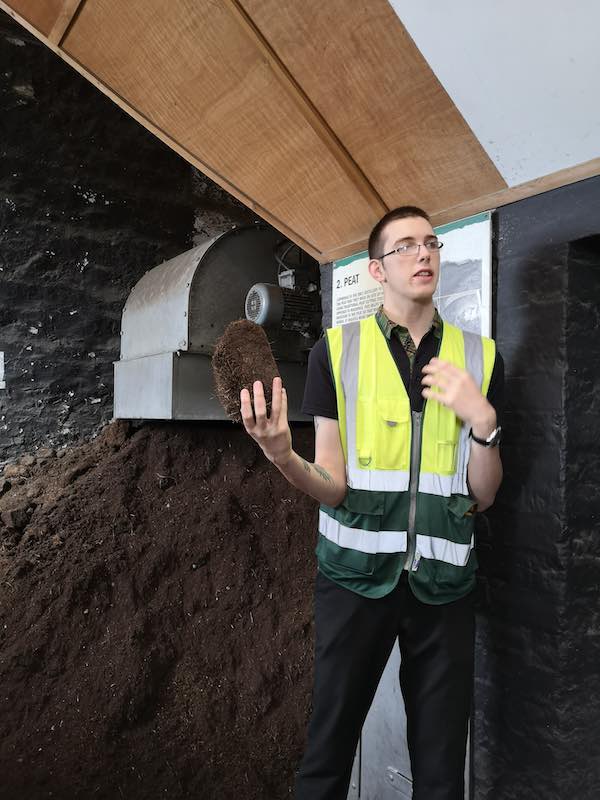
Peat Lesson
Our knowledgeable guide also worked us through a lesson on peat on Islay as well, explaining how Laphroaig cuts its peat.
We learned that peat location plays a big part in the kind of peat smoke the distillery wanted. Islay peat is the product of salt-sprayed heather, ferns, gorse, sphagnum moss, moorland grass and seaweed. The combination gives Laphroaig its signature salty, medicinal and coastal notes that creates controversial reactions all over the world. The distillery owns peat beds on the east shores of Loch Indaal, near to the Islay airport. The team looks after the peat beds, making sure that they are in the right conditions for the cutting which is usually done between April to September every year.
Laphroaig distillery is the last distillery on Islay that is still hand-cutting its peat. Usually, hand-cut peat is wet enough to make lots of smoke, which is perfect for Laphroaig.
We moved on to the mash house, where our guide treated us to more information about the whisky-making process. The mash tun gets three lots of water to extract the sugar from the malted barley. The first lot of water is at 63 degrees C; the second lot at 80 degrees C, and the last lot at 90 degrees C. The first and second lot of water move to the washbacks, while the last lot of water goes back to the mash tun as the first lot of water for the next mash. The sugary liquid, or wort, then cools to about 19 degrees C and moves to the stainless steel washbacks.
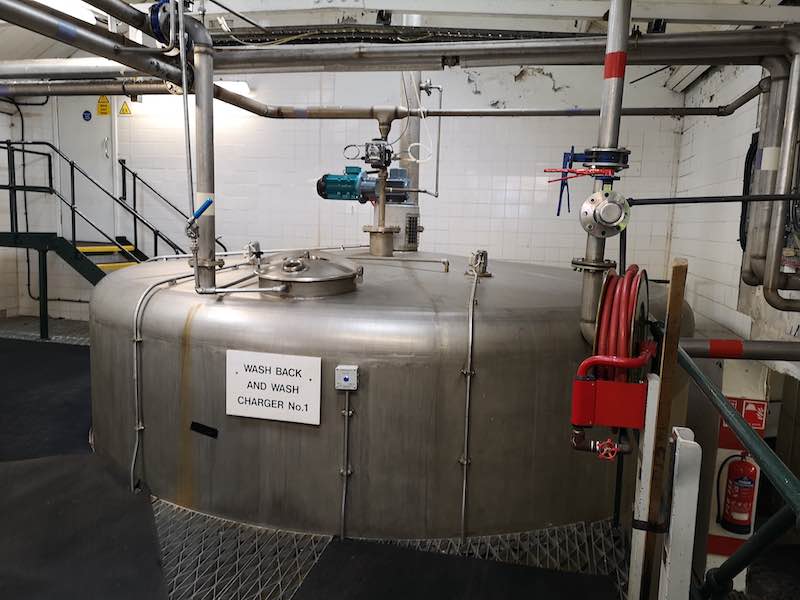
Washback
Laphroaig used liquid yeast, and the team adds it to the wort in the washback. Fermentation happens, and it yields a low wine (beer) at roughly 8.5% abv. Again, we were excited when our guides offered to let us taste the low wine!
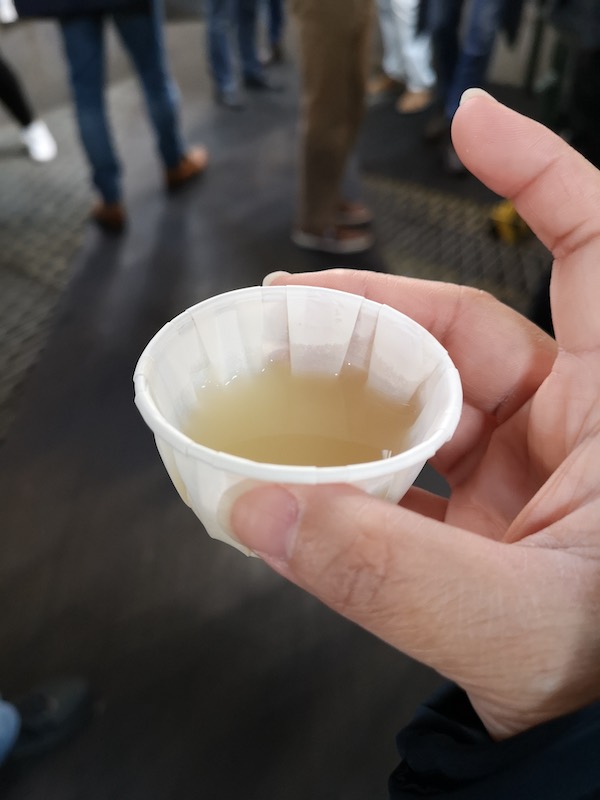
My cup of Laphroaig “beer.”
Laphroaig also makes excellent “beer”! It is slightly peaty and smokey, coupled with plenty of sweetness. In my opinion, it tasted even better than the one we had at Kilchoman! Considering that I dislike Laphroaig, I believe I would instead drink its beer (if the distillery ever decides to release one)!
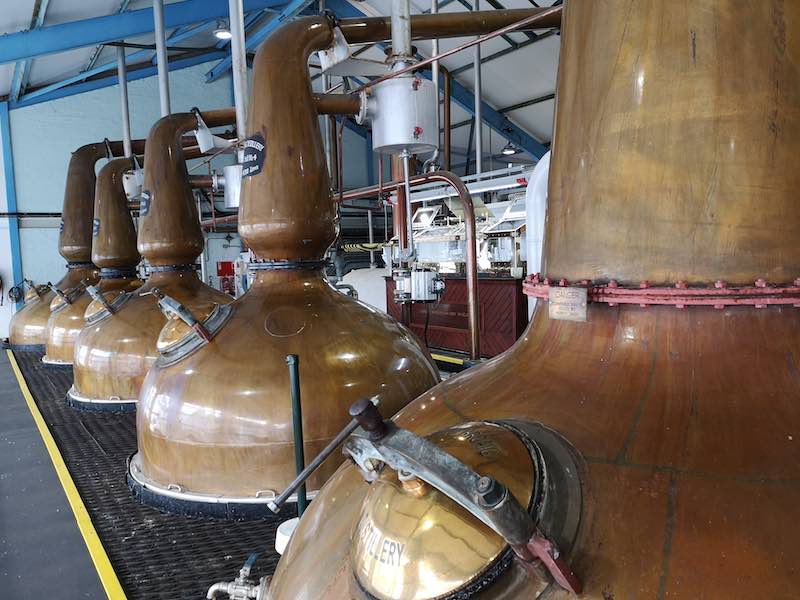
Spirits Still (four in the back); Wash Still (in the foreground)
Our group trotted to the Still House like a bunch of eager children who had been promised chocolates. Once there, we wowed over the seven stills standing proudly in front of us. There are three wash stills and four spirits stills. Each wash still holds 10,400 litres, while the spirits stills vary in their volume.
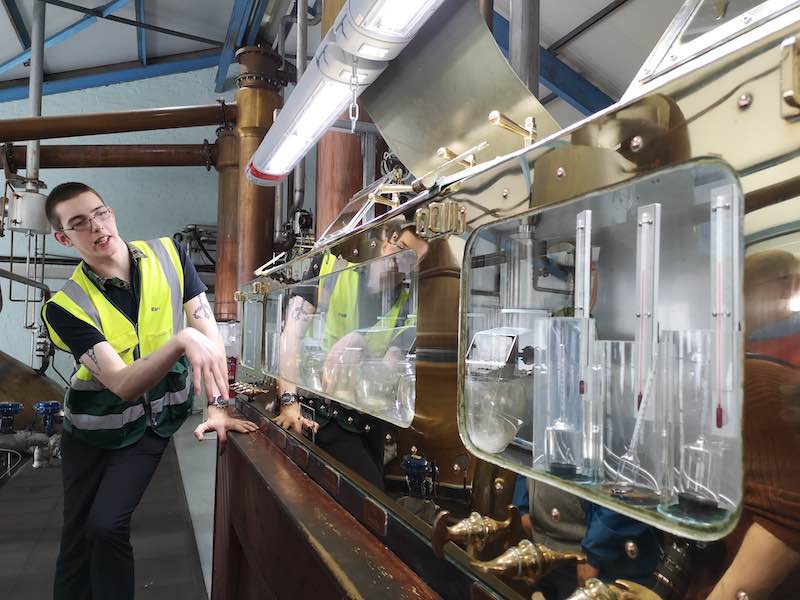
Spirit Safe
The first distillation through the wash still increases the alcohol percentage from 8.5% abv to around 20-25% abv. The lyne arms slope upwards to get more reflux, which helps to increase the strength of the distilled spirit. The second distillation goes through the spirits stills and alcohol percentage goes up to above 80% abv. Laphroaig takes the cut of the heart between 78% to 62%.
Whisky cannot be whisky if it is not matured for a minimum of three years in Scotland. We headed off to the warehouse once we completed the still house tour.

Laphroaig Warehouse
A quick look at the warehouse showed rows and rows of casks lying in the dark and moist environment, waiting for their turn to shine as whisky in a prized bottle. As our tour was a cask strength whisky-tasting tour, we knew what laid ahead.
Our guide finally bought us to a low-lying warehouse where we see three casks waiting for us. Our group sat down and waited with bated breath as our guide explained the procedure of tasting the three cask-strength whiskies and how we should bottle our favourite into the glass bottles provided. The three casks consisted of a bourbon barrel, a Manzanilla Sherry butt and a Fino Sherry butt.
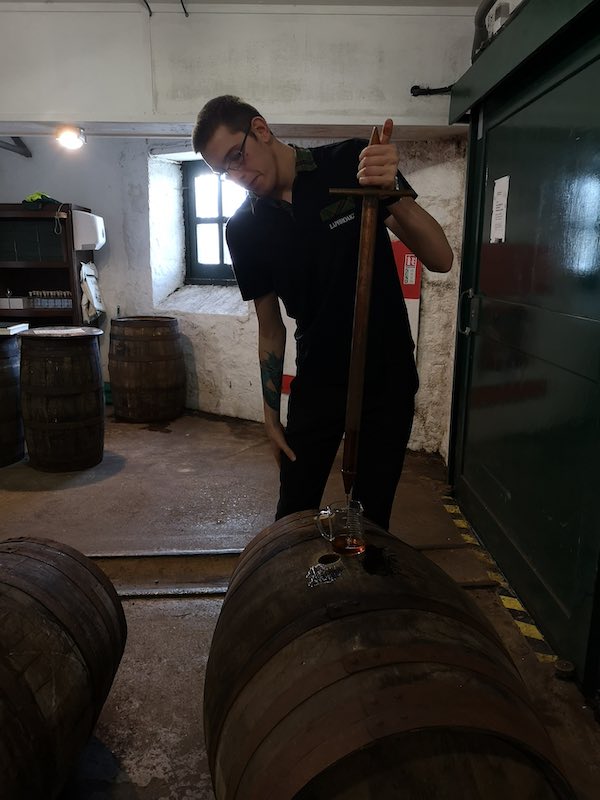
Our guide showing us how to draw whisky from the cask
We were all given a taste of the three casks, and then our guide waited for us to decide on the whisky that we wanted to bottle. Some of the participants rushed to the casks, but we took some time to decide. Our final choices were the bourbon barrel and the Manzanilla Sherry butt.
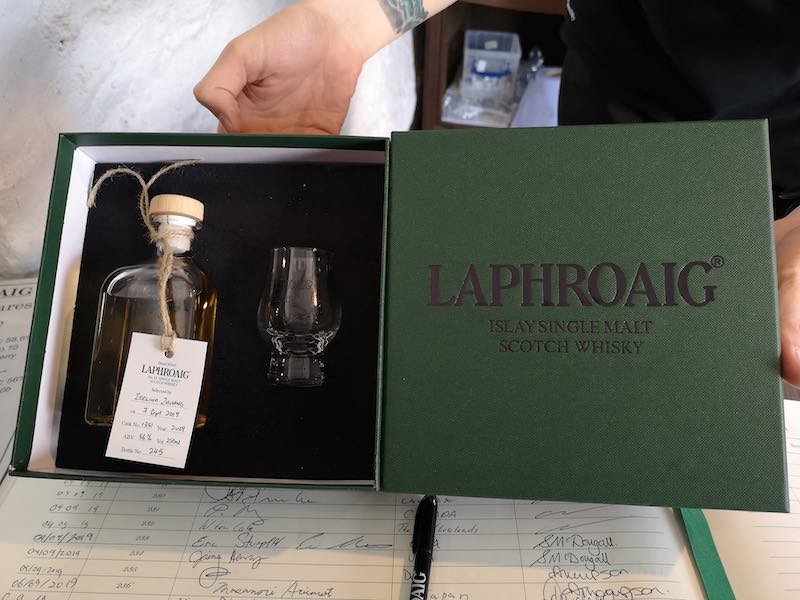
The Final Look
Bottling took longer than expected due to the crowd in our group, but we finally got our hands on the finished products! The above picture showed my bottle nicely sitting inside a beautiful package. Sadly, the box did not survive the flight back, and we had to throw it away in Edinburgh. Nonetheless, the bottle and the glass survived!
Back at the visitor centre, we claimed our rental for the plot of land that we “own” on Laphroaig’s peat bed. While we did not have time to visit our little plot, it was good to get our rental “payment” of it.
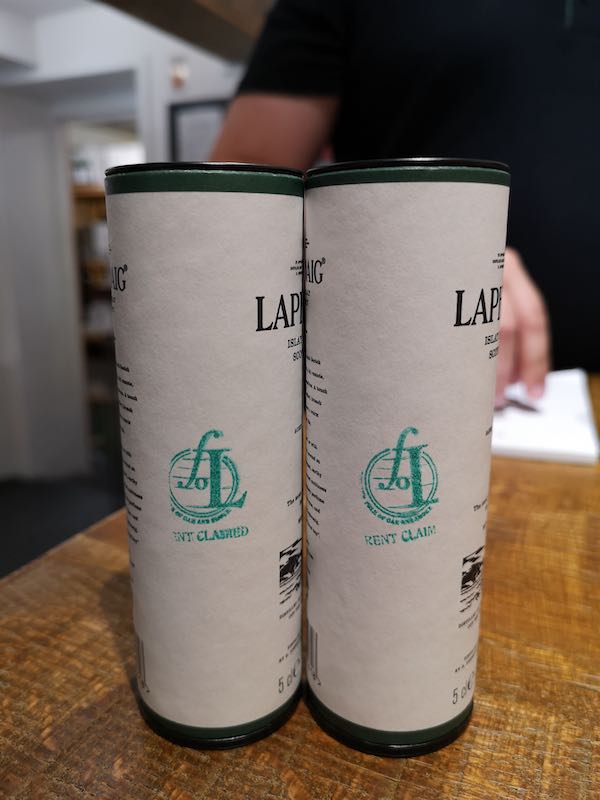
Our rental payment
If you are a friend of Laphroaig, remember to claim your rent at the visitor centre when you visit the distillery. It is available once a year and if you are lucky to visit them every year, claim it! We moved on to the next distillery soon after our tour as we were on a tight schedule, but Laphroaig distillery truly gave me one of the best distillery tours on Islay.
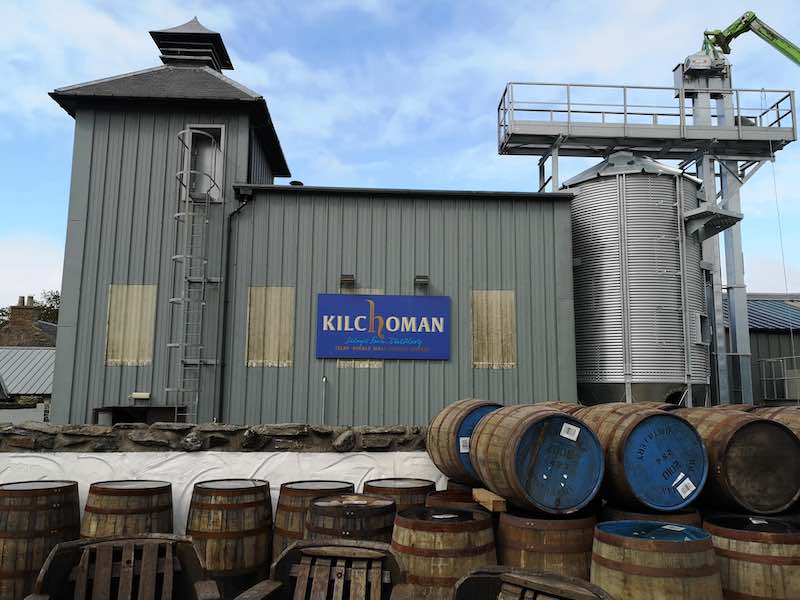
Kilchoman Distillery
Two team members from WhiskyGeeks went on an Islay-centric Scotland tour in September 2019 and we had a whale of a time! Coming back from Scotland was torturous, but such is life! It took us many months to get our bum to settle down in front of our computers to start writing, but here we are, finally!
Let’s start our journey with Kilchoman, the second newest distillery on Islay. The distillery started distillation in 2005 and have since expanded their production to 220 thousand litres of pure alcohol a year! New washbacks and stills will be installed soon, and we can expect increased production after that.
It was fun going on a distillery tour, mainly because you get to see all the machines and get behind the storefront to see the actual production hall. On Islay, the distilleries normally consist of different buildings on the distillery grounds, and Kilchoman is not any different. We started the tour at the shop, where our lovely tour guide met us. She distributed our tour souvenir, a mini Glencairn glass and a lanyard, as we will be using them along the way. After the usual safety briefing, we were off!
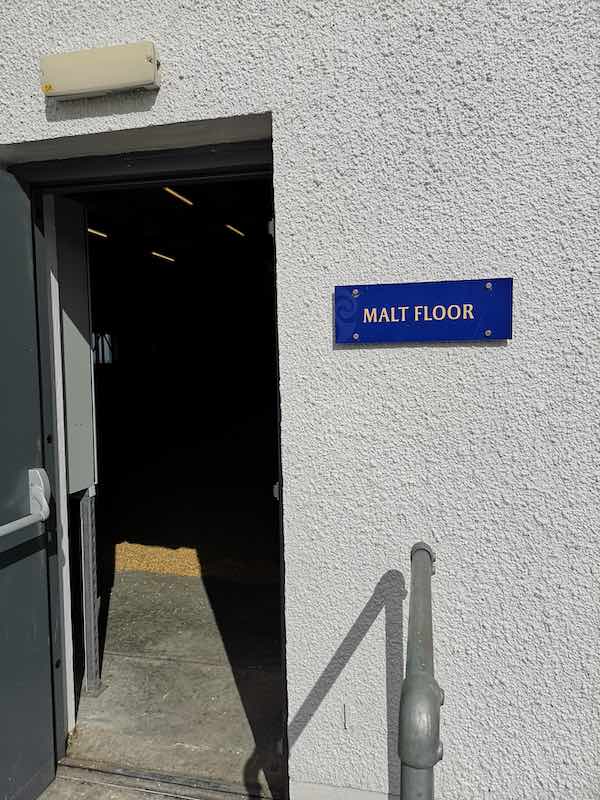
Entrance to the Malt Room
Kilchoman does some of their maltings onsite using Islay grown barley from the nearby Rock Side farm. Roughly 30% of the distilled spirit comes from Islay grown barley, while the rest comes from Port Ellen Maltings. Each malting is carried out in the traditional way of spreading the barley on the floor for germination to take place.
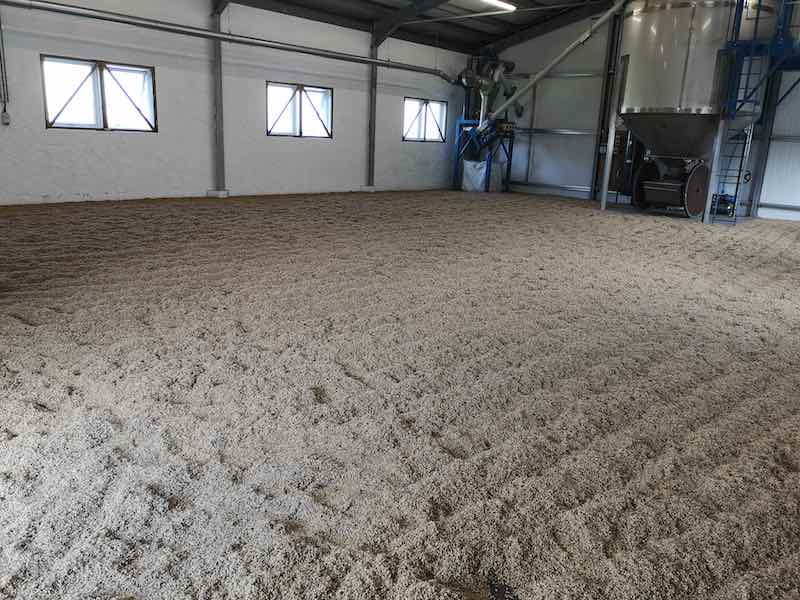
Traditional Malting Floor
Workers malt around 40 tons of barley at a time, by steeping them in water and allowing for 5-7 days of germination and drying.
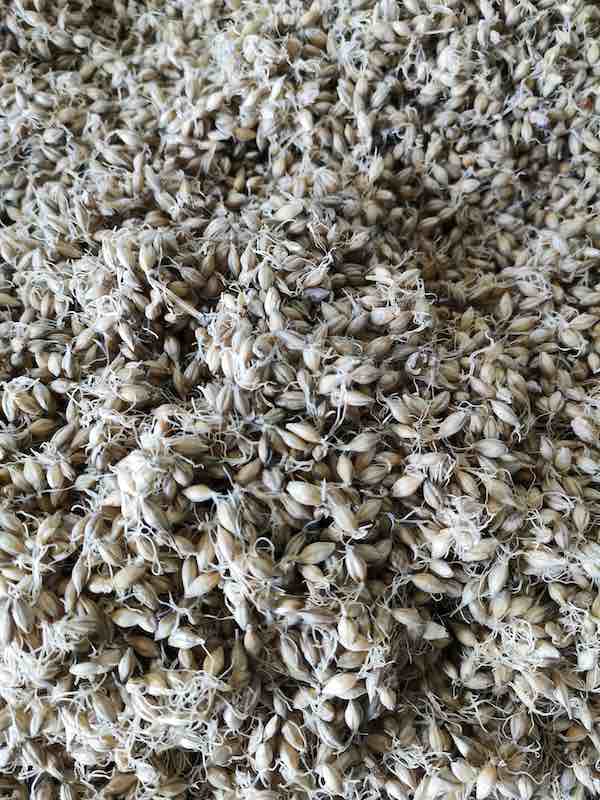
Barley germination in progress
During the germination, the plant shoot, or acrospire, will start growing. The malting is complete once the acrospire grows to around three quarters or more of the length of barley. Once the maltsters see that the barley is ready, they will start the kilning process.
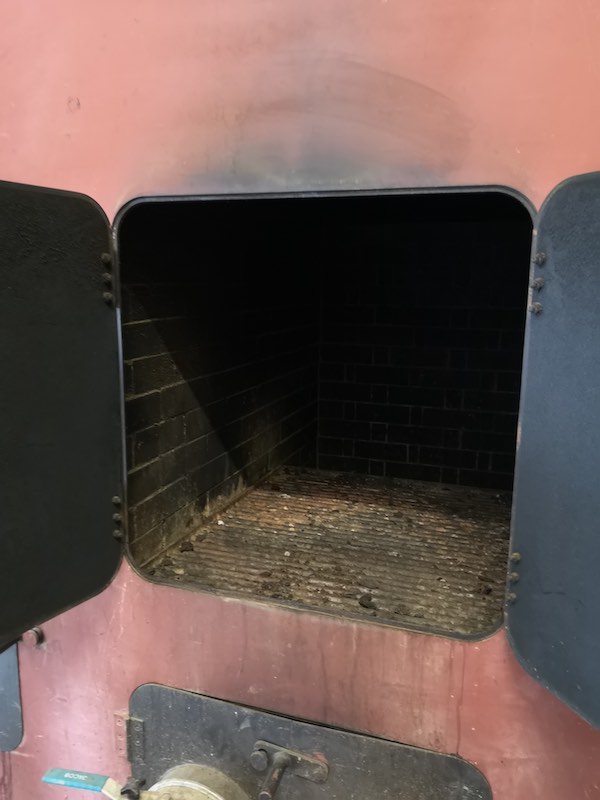
The Kiln
The kilning begins by igniting dry peat to get the fire going before adding wet peat to create peat smoke. The workers will smoke the barley for 10 hours and leave it to dry until the malt reaches 5% moisture content. This malting onsite leads to a 20ppm phenol content in the Islay malt. To follow the traditional way of malting, Kilchoman lets the barley rest for four days after kilning and before milling them for mashing and fermentation.
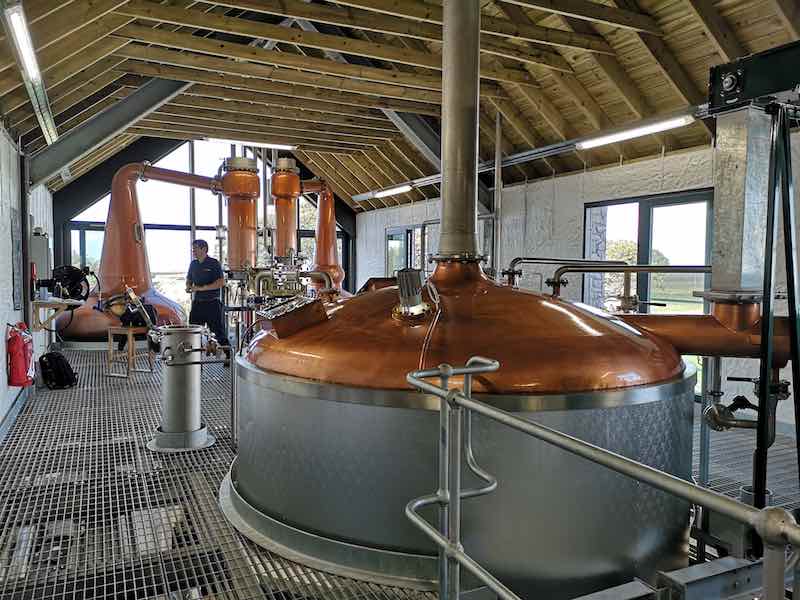
The Still House
Kilchoman is a farmhouse distillery, which means that space is limited. To make work effective, the mash tun, washbacks and stills are placed in the same location.
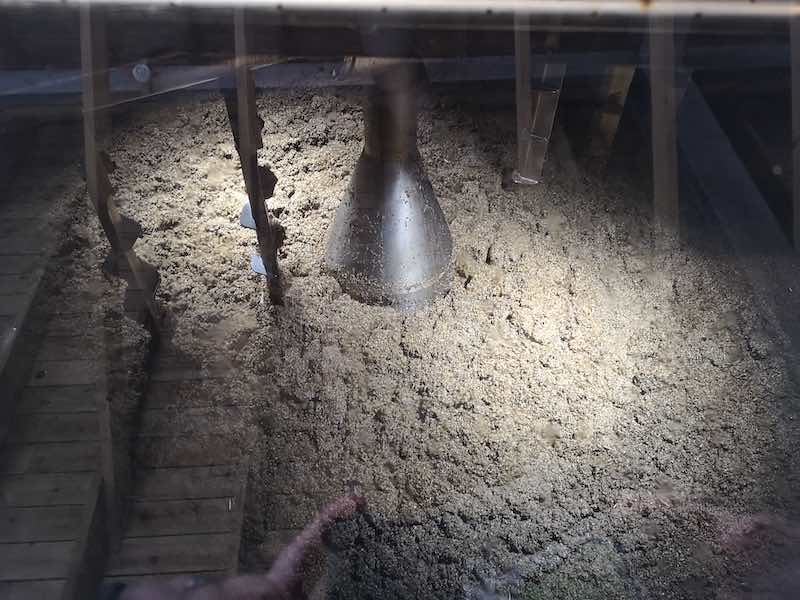
After milling, 1.2 tonnes of grist goes into the mash tun. To extract the sugars, the workers add three streams of hot water at 56degC, 85degC and 95 degC. 6000L of sugary liquid, or wort, goes into the washbacks, along with 20kg of dry yeast. This wort is then left to ferment for approximately 84 hours to become wash, a strong beer at 6-8% abv.
Our tour guide asked if we would like to try the “Kilchoman beer” and proceed to pour us some when she got a resounding “YES!”
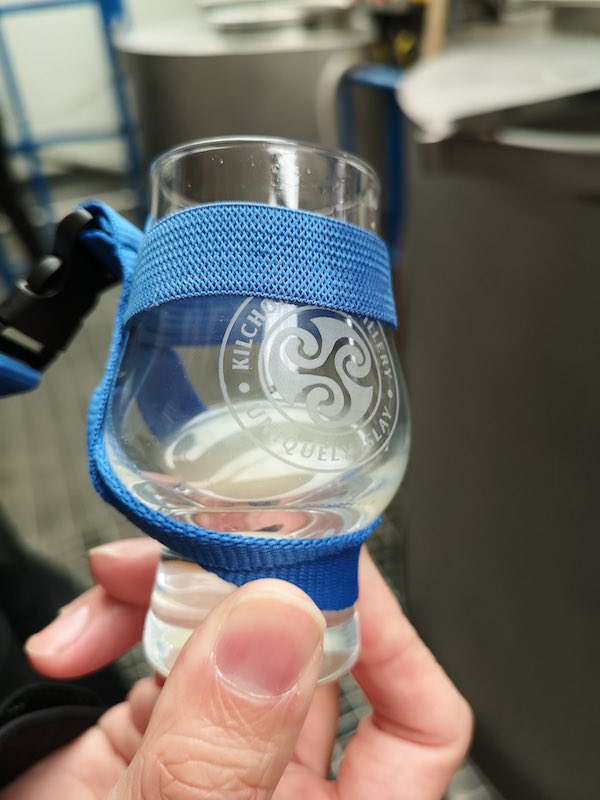
The Kilchoman Beer
The wash tasted sweet, with a yeasty, lightly fizzed note at the back. It was good! So good that we asked for a second helping. Personally, I think that Kilchoman should consider making their own beer. I would buy them if they make it!
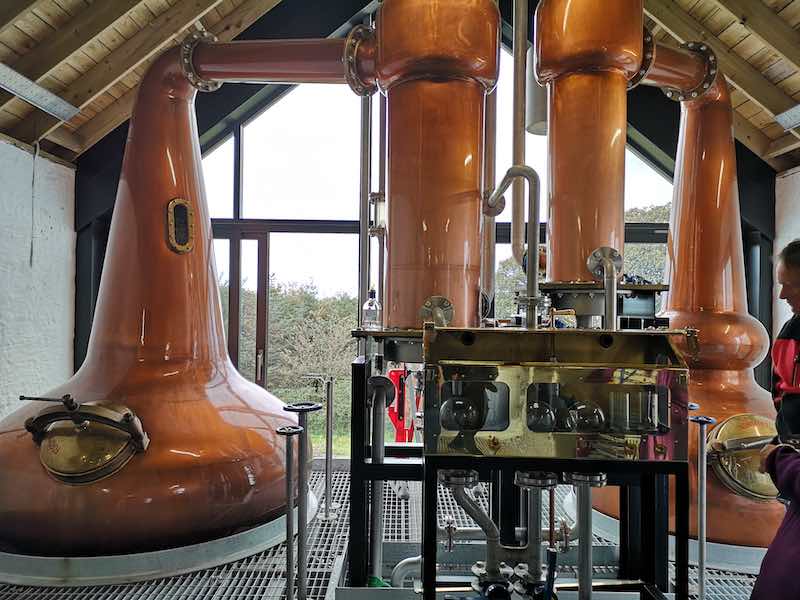
The Stills
Since the stills are pretty small, only 3000L of wash goes into the wash still at a time. After the first distillation, 1000L of low wines at approximately 19% abv goes into the spirit still for the second distillation. The remaining 2000L became pot ale, which is used to fertilise the crops at Rock Side Farm. Pot ale is useless for making whisky, but its organic compounds made them perfect as fertilisers.
The low wines from the wash still, and the heads and tails from previous distillations are then added into the spirit still at approximately 26% for the second distillation. Kilchoman takes the cut of the heart between 76% and 65%; this means any distillate above 76% are foreshots, and any distillate below 65% are feints. These foreshots and feints are added to the low wines in the next distillation. After 3.5 hours of distillation, the spirit still produces 3.5 litres of spirit, which will be watered down to a filling strength of 63.5%.
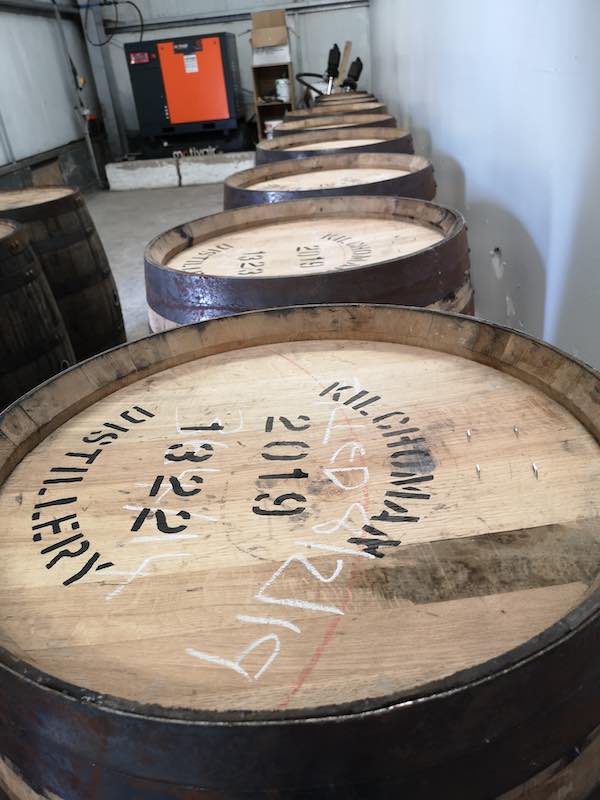
Sample Casks
Unfortunately, Kilchoman distillery has a policy that does not allow visitors to see their warehouse. It is due to safety reasons though; they have nothing to hide! Instead, we got to see some sample casks which the tour guide explained their way of storage before she led us to the next exciting part of the distillery tour.
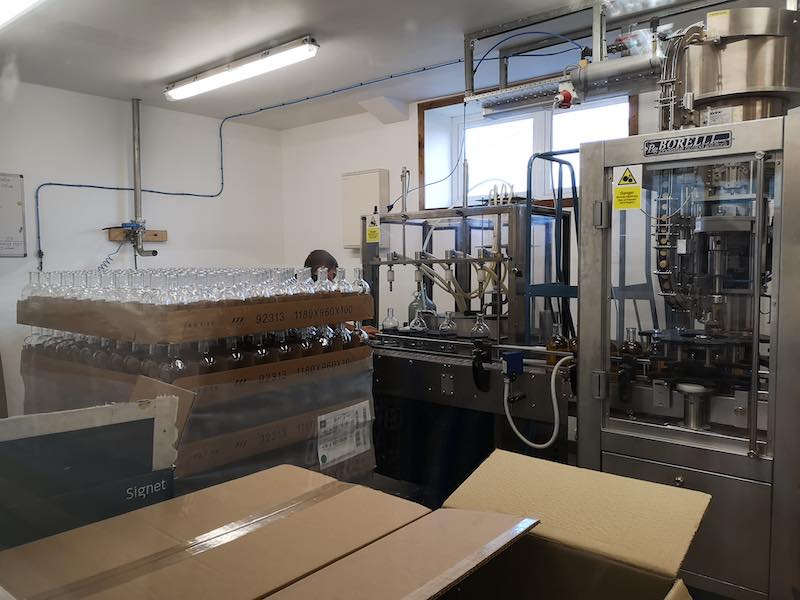
The machine that helps to bottle Kilchoman Single Malt
The bottling process is a combination of manual and machine work. The bottling team needs to ensure the cleanliness of the bottles before feeding them to the machine, which will do the bottling. In the above picture, you can see the process of filling the bottle. The filled bottles then passed through the glass portion of the machine where the cork gets fixed onto the bottle. The final process gets the bottles sealed and labelled! The bottling team then completes the process by putting the bottles into their boxes and packed them into cases of six.
Our tour guide led us back to the distillery shop and ended the tour. You must be surprised to see that we did not appear to taste any Kilchoman whisky. We did! It just did not flow nicely in the narratives earlier. We had a Sanaig in the malting room and it was surprisingly good! We got to admit that we are not big Kilchoman fans largely because we find it spicy, but the Sanaig was really awesome.
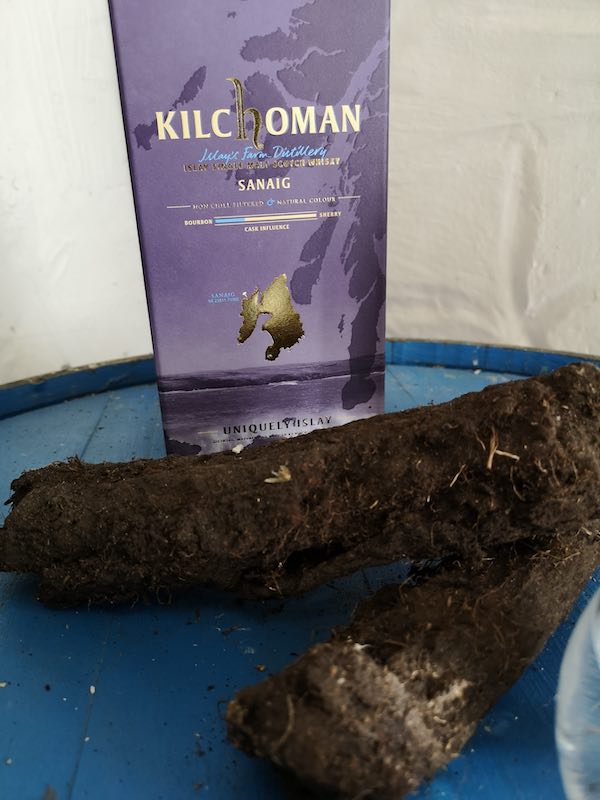
Sanaig and peat
Back at the shop, we considered having a meal at Kilchoman because we heard that the food was awesome! Alas, we cannot, as we needed to move on to the next distillery. Nonetheless, we had enough time to explore the little farmhouse at the back of the distillery and the below pictures were what we found!
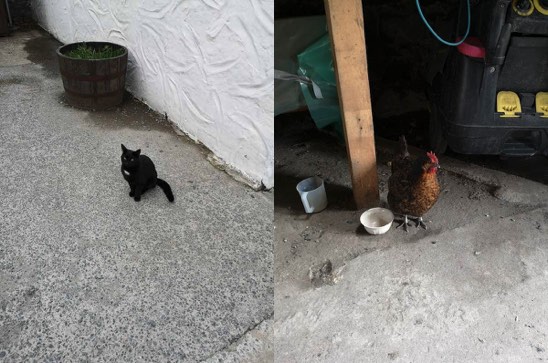
The Kilchoman Cat and Hen
There were some other hens running around but they ran away when they saw us. Hahaha…
It was a fantastic visit to Kilchoman, and we look forward to seeing more of them after their expansion.
Back in December, Whiskygeeks was invited to an exclusive Cognac Park tasting. After trying some non-traditional Cognacs, I found an excellent malternative.
As enjoyable as whisky might be, having too much of a good thing could get boring or burn you out. It’s essential to give your palate a break sometimes, and a Malt Whisky Alternative, or Malternative, could give you such a change.
Good whisky Malternatives should be quality spirits as well, and one such example is Cognac.
Cognac is an aged grape spirit from the region of Cognac in France under a specific set of rules called the AOC designation, dictating how it can be made. You can find the document (in French) here.
White grapes will ferment for 2 to 3 weeks till it reaches 7-10% abv. Cognac distilleries use Charentais copper pot stills for double distillation in a similar fashion to Scotch single malt. In the first distillation, the white wine becomes Brouillis, equivalent to low wines in Single Malt distillation. The brouillis, at approximately 30%, undergoes a second distillation, also known as Bonne Chauffe. The distillates then split into heads, hearts and tails, just like whisky. Only the heart portion goes into French oak barrels for maturation. The distillery will not throw out heads and tails. Instead, they will add the head and tails back into the wine or brouillis for the next distillation. Both distillations require about 24 hours in total, so the Charentais pot stills are running 24/7 during distillation.
The cognac “new-make spirit” or eau de vie goes into French Limousin oak casks for maturation. The angel’s share is around 3% on average, slightly higher than Scotland.
In whisky, producers use a wide variety of barley strains, but Cognac distilleries primarily use Ugni Blanc after the phylloxera mould crisis of the 1960s. The grape is disease resistant, high in acidity and low in sugar. Such properties make Ugni Blanc a suitable grape for making Cognac. Cognac Park uses approximately 60% Ugni Blanc for their Mizunara range. Imagine if the SWA proposed that rule to use barley varieties like Golden Promise, Triumph or Bere Barley.
The Charentais stills for cognac distillation use must be direct-fire heating as well. Many Scottish distilleries, on the other hand, that have switched to steam coils.
Unlike Scotch and many other spirits, Cognac distillation, with accordance to the Cognac Appellation, can only occur around late November to March.
Cognac Park is in the Borderies, the smallest growing cru in the region, just 4,000 hectares under vineyard cultivation. The soil in the Borderies is prized for its limestone and chalky properties. This terroir could be the reason why cognac from this region has characteristic floral notes of violet. Cognacs in the Borderies region also have a reputation of requiring a shorter maturation time for the same quality. The entire Cognac Mizunara collection are all Single Cru Cognacs meaning that the grapes used are exclusively from the Borderies region.
The Mizunara casks used for Cognac Park must be virgin casks; which means that it cannot have aged spirits before, similar to bourbon. The Mizunara cask finish also cannot extend beyond 12 months. Otherwise, the cask could lose its appellation, and the cask cannot be considered a Cognac anymore.
Now to the Cognac! The Cognac Park Mizunara matures in French oak for 4 years before a 6-month finish in virgin Mizunara casks. This NAS was one of my favourites before the I tasted Single Cask. With the 10-year-old Mizunara, it generally has more Cognac characters with a nice layer of Mizunara complexity. However, due to the longer 10-month finish in virgin Mizunara casks, the patient drinkers amongst us will be rewarded. Regardless, I would definitely recommend this to anyone who enjoys Cognac previously.
The vintage 2006 single cask was extraordinary, primarily due to its higher alcohol strength that allows the cognac’s complexity to shine. This single cask portrays many flavours similar to a youthful yet tender single cask whisky. The last Cigar Blend was mindblowing as well in terms of age and taste. The Cigar blend contains cognac ranging from 25 to 32 years old that has leather and tobacco flavours similar to sherried single malt in its mid-twenties or older!
Many thanks to Spirits Castle for the invite to this exclusive tasting. These bottles can be bought locally here! If you are interested in the tasting notes, I have left my opinion down below!
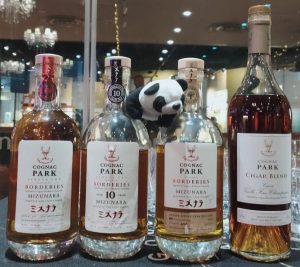
Nose: Notes of raisins, dried fruits. Insense notes, a hint of black pepper and sandalwood. With water, notes of brioche started to appear.
Palate: Orange peel, sandalwood, incense, herbal note, earthy notes. With water, oak spice and sandalwood.
Finish: Herbal note, vegetal notes, sandalwood, With water, cinnamon spice and black pepper.
Cognac Park 10yo Mizunara Finish
Nose: Soft nose, rich raisins, figs, red apples, black pepper, umami note, floral notes, milk chocolate. With water, cinnamon, star anise, brioche, oak and honey.
Palate: Floral note, orange peel, parfait armour, ripe red apple. With water, vanilla, cinnamon and toasted oak.
Finish: Incense note, black pepper spice, raisins and walnuts.
Cognac Park 9yo 2006 Single Cask Mizunara Finish
Nose: Green Pears, hints of orange, honey, herbal note, black pepper, vanilla, lemon zest. With water, more confectionary sweetness and green apples
Palate: sandalwood, vegetal note, earthy notes, umami notes, confectionery sweetness, With water: green apple, herbal sweets, minty cooling sweets
Finish: sandalwood, black pepper, incense note. Water: more minerality, raisins.
11311 Harry Hines Blvd
Dallas, TX, United States
(555) 389 976
dallas@enfold-restaurant.com
